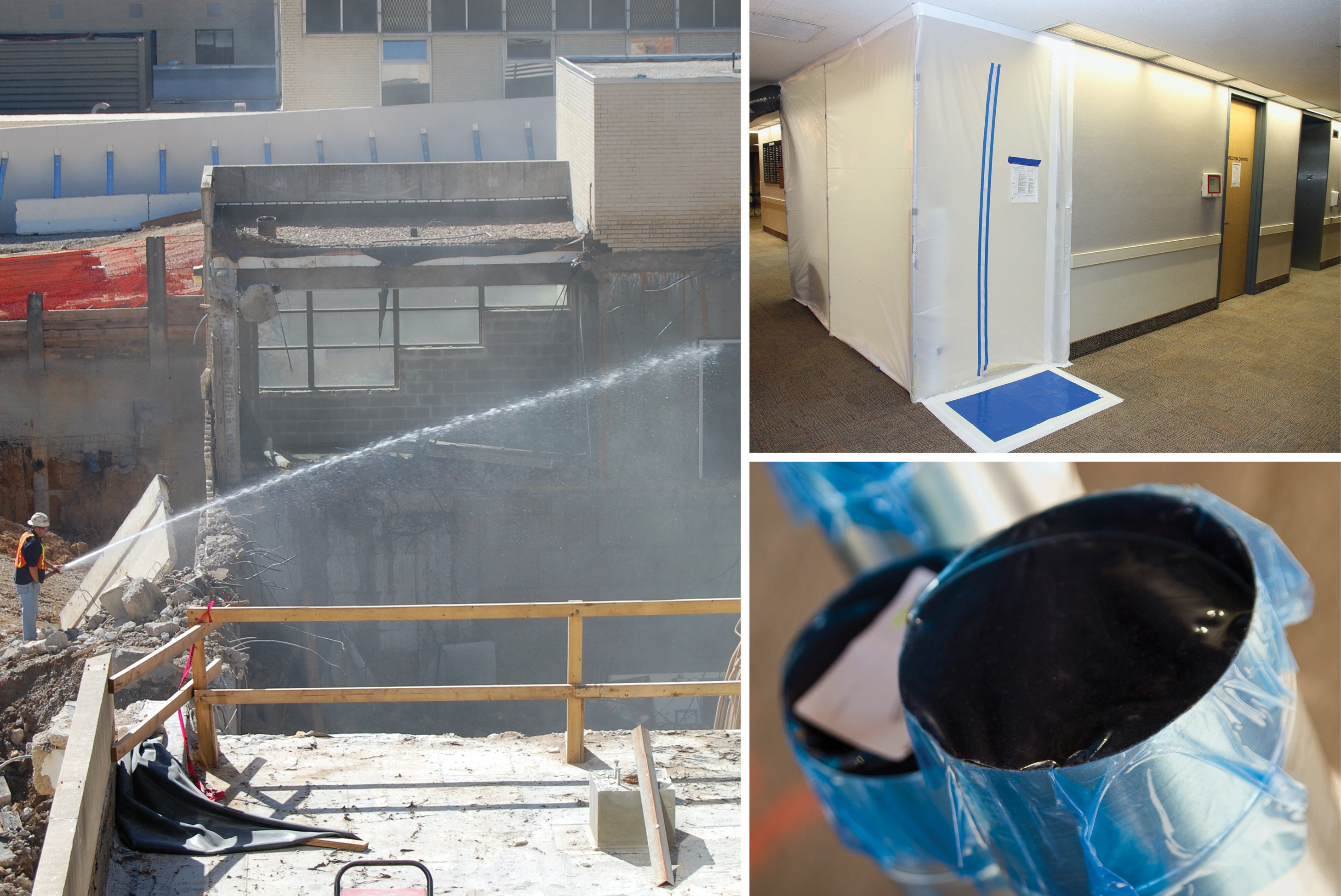Conducting infection control risk assessments the right way

The connection between health care facility construction and work activities and increased patient infection risks is well documented.
Images courtesy of ASHE
An infection control risk assessment (ICRA) is just one part of health care facility project planning that was developed to control risks during construction activities. It is a process that must be carefully planned and implemented to complete work safely in health care facilities.
The commonly accepted ICRA process and risk assessment tool was developed over 25 years ago and, until recently, has been an effective way to plan for and eliminate infection risks associated with construction.
However, the American Society for Health Care Engineering’s (ASHE’s) recently released update includes a better understanding of the ICRA process, expanded definitions of work activities and areas, and greater explanation of controls.
This article is excerpted and edited from the ASHE resource guide, titled “ASHE ICRA 2.0™ Process Guide,” which is part of a series of related tools and educational programs, the ASHE ICRA 2.0™ Toolkit.
ASHE ICRA 2.0 applications
An ICRA is required anytime construction, renovation and maintenance (CRM) or significant work involving alteration or replacement of building systems is performed that creates dust or impacts environmental conditions that could affect health and increase infection risk, such as disruption of water or ventilation systems; demolition or construction activities creating dust; interference with patients, care providers or supply pathways through the building; and when replacing surfacing materials and equipment.
While in the past ICRA was used primarily for construction-related work, to encourage a patient-first culture with infection control embedded into processes, ASHE recommends ICRA be used more comprehensively. This means using the ICRA in work involving contractors or construction personnel, but it can also include work performed by health care facilities’ in-house personnel.
Tips for building an ICRA team
The most effective infection control risk assessment (ICRA) team is one that is multidisciplinary, meaning it represents various groups and departments. The ICRA process involves gathering information, and the multidisciplinary team verifies that this information is correct from multiple areas of expertise. While team structure will vary between organizations, there are several core players that should remain constant regardless of health care facility designation. The American Society for Health Care Engineering (ASHE) recognizes the following as the core group of the ICRA team:
- Leadership/executive.
- Infection preventionist.
- Facilities/project management.
- Clinical/nursing management.
- Occupational or environmental safety management.
- Support services.
- Department(s) affected.
This membership should be in place for successful planning. In addition, the team must consider the needs of any authorities having jurisdiction to achieve full compliance. The team member concept must have defined roles in the ICRA process.
The ICRA process requirements are not limited to hospitals. All health care facilities should assess for risk with the ASHE ICRA 2.0 criteria. That includes (but may not be limited to) Centers for Medicare & Medicaid Services-licensed facilities and any others that an authority having jurisdiction requires, such as hospitals; ambulatory care facilities; long-term care facilities (e.g., nursing homes); elder care centers; health care clinics; treatment centers, including dialysis centers; medical office space; medical arts buildings where patients enter; and behavioral health settings.
The process starts with the hospital or facility project manager developing clear and accurate project information to present to the ICRA team. While including the contractor or other non-health care staff can be appropriate, it is the health care organization’s responsibility to collect all information and complete the ICRA process, not that of the contractor or person doing the work.
Overall information needed to assess risks and define classes of precautions includes type of work to be done, and area or location of work activities.
A safety risk assessment (SRA) or pre-construction risk assessment (PCRA) is a necessary component of the early project planning phase needed to identify and assess potential impacts and/or risks to the facility systems as well as potential impacts to patients, staff and visitors. This pre-assessment includes a review of the potential impact to building systems (medical gas, electrical, plumbing, mechanical, communication, security, life safety and other systems supporting patient care) and spaces. The SRA/PCRA recommendations will need to be evaluated during the ICRA process, which comes later in the design phase when the actual work activities have been determined.
Completing the ICRA is the responsibility of the health care organization requesting or contracting the work and/or in which the work is performed. The responsibility also falls on the organization to institute effective controls, communicate required precautions, enforce the use of precautions and update precautionary measures when needed. Some projects only require one ICRA, while more detailed projects can include multiple ICRAs for multiple phases of work performed.
An all-team approach is required to develop a successful ICRA (see sidebar on right).
Five-step process
ASHE ICRA 2.0 is organized into five distinct steps that occur at the onset of project design, before any work is underway. Completing an ICRA involves selecting several assessment elements to determine the necessary “class of precautions” to implement for the project or work activities. The steps include the following:
Step 1: Define the activity. The connection between health care facility construction and work activities and increased patient infection risks is well documented. Soiled or dirty clothing, tools and materials can increase dispersed dust and contaminants in the health care environment. It is important to set expectations about worker activities and ensure that the worker actions discussed in this section are closely considered.
Additionally, the methods and locations of trash collection and removal directly impact the indoor environment. Materials staging, trash container locations and equipment/trash container proximity to air intakes have all been associated with increased risk of patient infection.
Work must be completed following the assigned ICRA precautions. Incidental work or actions outside the assigned precautions must be prohibited. The ICRA team and contractor must monitor actions and incidental work processes that are the result of changes or daily modifications. Workers must be trained to understand the impact of taking any incidental actions and to follow appropriate ICRA precautions.
Workers entering the work area must follow the listed ICRA precautions. Shoe covers and coveralls are required in higher classes of precautions and must be removed before leaving the work area. Adhesive mats must be used to clean bottoms of shoes/boots before leaving the work area.
All worker clothing, including foot covers and head covers (hard hats), must be clean and free of visible dust, dirt or debris when entering the health care environment. In turn, these same items must be visibly clean and free of visible dust, dirt or debris when leaving construction and renovation work areas and returning to the health care environment. Workers entering the facility with equipment, tools and supplies must ensure that all items are clean and in sanitary condition. Building materials must not have visible dust, dirt or debris when transported in the facility. All material cutting or assembly must be completed in the contained work area or outdoors prior to entry.
Material movement and transportation must be completed through designated pathways away from patient care areas. Designated entries and elevators for transport of supplies, workers and equipment must be designed.
Prior to any type of work beginning, whether it be maintenance or large construction, the ASHE ICRA 2.0 requires the ICRA team to consider the implications of the activity and their associated risks.
The ASHE ICRA 2.0 form provides guidelines, but the team and the facility must come to agreement on the application of those guidelines in the setting where the work will take place. It is important to communicate when recommendations will be adhered to directly or when they need to be adjusted to apply to the specific situation more accurately.
Step 2: Identify patient risk. The relationship between CRM activities conducted in health care facilities and increased patient infection risk is well recognized.
At-risk patients can be exposed and infected through the introduction and dispersal of contaminants in the health care environment. It is understood that CRM activities can increase the risk of infectious contaminants being released into the health care environment, thus putting patients, staff and visitors at risk of exposure.
Mapping critical care areas will help the team take the right precautions. Not all patients carry the same level of risk or require the same level of environmental controls. By knowing which patient populations are most susceptible to CRM activities, the ICRA team can actively reduce the potential of exposing health care patients unnecessarily.
It is the responsibility of the ICRA team conducting the risk assessment to accurately recognize the correct patient risk groups before and throughout the project so that the appropriate safeguards can be implemented and diligently maintained. While the emphasis within the ICRA process has always been focused on patient risk groups, the ICRA team must also consider impacts on staff and visitors within the impacted areas.
Within Step 2, the degree of risk is ranked starting with the lowest risk environments, specifically non-patient care areas, and terminating at the highest risk, which includes procedural, invasive, sterile support and highly compromised patient care areas. A clear and concise approach to patient risk group identification helps users appreciate the escalation of human health risk associated with specific areas of the health care facility.
Much of the ASHE ICRA 2.0 assumes that CRM work will occur in areas where patients may be present but with the required controls and protections in place to mitigate risk. In cases where those conditions are not ensured, it may be best to plan for patient relocation until work is completed.
Step 3: Define class of precaution. In all projects, protections are adapted to make the work safer for both workers and occupants within adjoining spaces where the work takes place. Infection prevention controls can prompt many different actions. Controls that may be introduced during a project include protective clothing (cover suits and shoe covers), impact reduction, barriers, ventilation and airflow, exhaust and air filtration, water systems flushing, systems shutdowns and backups, trash and debris containment, anterooms, rerouted traffic flow and egress, and enhanced cleaning in the areas.
The precaution classification matrix in ASHE ICRA 2.0 offers five distinct classes of precautions based on the identified activity type and patient risk group. Each class lists control elements to be implemented before start of work and maintained during work activities. The ICRA document should be reviewed each time there are substantial changes to the work effort, which can either increase or decrease the classification.
The intent of the matrix is to provide the level of mitigation necessary only at a given point of a project. Many projects begin with higher classes of precautions, primarily due to demolition activities, then require stepdown levels of precaution on the journey to completion.
Step 4: Assess surrounding area. A prerequisite to being able to adequately assess risks in surrounding areas is having accurate, in-depth knowledge and information about the building and its systems. It is imperative to include someone on the team, usually the facility manager, who can provide this information. Accurate life safety drawings will be valuable in assessing impacts on life safety. Line-drawings of electrical systems, building system drawings and institutional knowledge may be needed to adequately assess risks and develop control measures.
Areas adjacent to, above and below the construction or renovation site can be impacted by work activities. The patient risk group for these areas may be different than in the immediate vicinity of the construction work and may be a higher risk group.
Controls for additional areas potentially impacted by projects must be assessed. These areas generally include the immediate adjacent areas and spaces above and below the immediate work areas. Controls for adjacent areas may be significantly different than the project work area depending on the work performed.
These areas commonly are impacted by noise from hammering and work; vibration issues caused by construction activities; additional dust or debris from core drilling, hammering or equipment movement; ventilation disruption, including alteration of required pressure differentials, air exchanges, and temperature and humidity control; vertical connections between floors that could provide a pathway for migration of dust and airborne pathogens such as stairways, elevators and vertical lift shafts; disruption of data management systems; disruptions in hot and cold water systems that could cause stagnation; disruption of other mechanical systems and utilities; and disruption of medical gas and vacuum systems.
Often, the impact spreads beyond just the adjacent areas and the areas immediately above and below a work site. The scope of work, the impacted systems and the areas they serve, and physical connections between areas must all be considered. The updated ASHE ICRA 2.0 document includes more detailed assessment criteria for consideration.
Additional impacts to consider during the ICRA process include building systems; sound levels; vibration; pressurization; indoor air quality, including relative humidity, temperature and control of airborne particles; vertical connections between floors; environmental contaminants; water disruption and water system management; medical gas, vacuum systems and waste anesthetic gas disposal systems; and electrical distribution systems.
Step 5: Establish mitigation plan. Developed to delineate the five classes of precautions outlined in Step 3, each class of mitigation provides detailed strategies to be implemented before start of and maintained during work activities. These activities typically represent the minimum safety net that needs to be established as prescribed within the tool.
Identifying the minimum required infection control mitigations using the table in the ICRA form is the next step. These controls are listed in the table by class of precautions and include several physical as well as individual personnel actions. These are the minimum requirements suggested by ASHE, but some discussion will be necessary to determine whether they are required per the specifications of the facility and the project.
Effectively implementing or installing the identified controls can be difficult. The process of implementation and design of the controls takes discussion, planning and time. The ICRA team must know what the elements of the controls entail and the specification requirements. Control elements include barriers, exhaust pressurization, location of exhaust air discharge, trash-moving equipment, contractor garbing requirements and anteroom requirements.
ASHE ICRA 2.0 controls listed in each class of precautions have been updated to provide better guidance on expectations for controls. Implementation of controls should be separated into the following categories for planning purposes: barrier protection requirements, ventilation and exhaust air requirements, worker activities, movement of materials and wastes, setup and removal of controls and precautionary measures, and environmental testing and monitoring.
Project phases
Completing and getting an ASHE ICRA 2.0 approved are only two of a total of four phases that comprise the work project. The ICRA should not only inform the mitigation risks and controls but also be engaged with through the entire project until its completion. These four project phases include:
- Assess and reassess. Use the ASHE ICRA 2.0 to gather information and determine the extent of work. Determine whether work activities are autonomous to engineering/facilities work.
- Approve. Approval by the ICRA team and determination of mitigation plan, including if standing orders are appropriate.
- Work and monitor. Work activities, controls, monitoring and continued reassessment.
- Close. Completion of work activities, cleaning and verification of system conditions.
The processes are continuous and require the ICRA team to assess/reassess on a routine basis. The importance of reassessment cannot be emphasized enough. Organizations sometimes fail to perform this function. Missed hazards and risks may materialize due to unforeseen project conditions.
The ICRA team must understand that a phased project most often requires modifications and reassessment of controls. Even after planning and completing the ASHE ICRA 2.0, the team may encounter unforeseen issues and building conditions that impact the work and the infection prevention controls that are needed. Therefore, a process of assessment and reassessment is important in any phase of work and as work progresses from one area to the next.
When work involves multiple phases with different levels of work, a separate ICRA should be created.
Closing out
While closing out a project is exciting, it is also challenging as it relates to infection control mitigation. But it will be a sweeter reward knowing that the risk of infections has been properly mitigated through the five steps of the ASHE ICRA 2.0 process.
The ASHE ICRA 2.0 guide authors
The key to successful guidance is to engage the talents of a multidisciplinary team. The American Society for Health Care Engineering (ASHE) thanks the authors for their time and expertise in this work:
- Robert D. Booth, MPH, CIH, senior health care/infectious disease and prevention consultant, Oncore Inc.
- Christopher Kobus, MS, R.N., CIC, safety officer, operations and maintenance, UW Medicine, University of Washington Medical Center.
- Richie Stever, MHA, CHFM, CLSS-HC, LEED AP, vice president of real estate and property management, University of Maryland Medical System.
Contributing authors
- Tim Adams, CHC, CHFM, FASHE, director, system environment of care and life safety, UI Health (retired), at the time of publication.
- Gregory Joseph Corso, CHFM, CHC, Naval Hospital Camp Pendleton.
- Jonathan Flannery, MHSA, CHFM, FASHE, FACHE, senior associate director of advocacy, ASHE.
- Susan Upton, architect II, Washington State Department of Health.
ASHE would like to specifically thank The Joint Commission Infection Prevention and Control and Standards Interpretation Group, Division of Healthcare Improvement, and the Association for Professionals in Infection Control and Epidemiology Practice Guidance Committee for their reviews of the process guide.
This article was excerpted and edited by Health Facilities Management staff from the American Society for Health Care Engineering resource guide “ASHE ICRA 2.0.™ Process Guide.”




